which function would you use to find the oldest date in a range?
In this tutorial, we are going to shed some lite on one of the most mysterious inhabitants of the Excel universe - the OFFSET part.
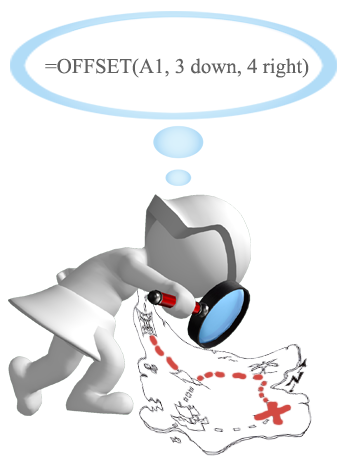
So, what is OFFSET in Excel? In a nutshell, the Showtime formula returns a reference to a range that is offset from a starting cell or a range of cells by a specified number of rows and columns.
The OFFSET function may exist a flake tricky to become, so let'due south get over a brusk technical explanation commencement (I'll do my all-time to go along it simple) and then nosotros will cover a few of the most efficient ways to utilize OFFSET in Excel.
Excel Offset office - syntax and bones uses
The Commencement part in Excel returns a cell or range of cells that is a given number of rows and columns from a given jail cell or range.
The syntax of the Outset function is as follows:
Commencement(reference, rows, cols, [height], [width])
The kickoff iii arguments are required and the last 2 are optional. All of the arguments can be references to other cells or results returned past other formulas.
It looks like Microsoft made a good effort to put some meaning into the parameters' names, and they practise requite a hint at what you are supposed to specify in each.
Required arguments:
- Reference - a prison cell or a range of adjacent cells from which you base the kickoff. You lot can think of it as the starting point.
- Rows - The number of rows to move from the starting point, up or down. If rows is a positive number, the formula moves below the starting reference, in instance of a negative number information technology goes above the starting reference.
- Cols - The number of columns you lot want the formula to move from the starting signal. As well as rows, cols tin can exist positive (to the right of the starting reference) or negative (to the left of the starting reference).
Optional arguments:
- Height - the height, in number of rows, of the returned reference.
- Width - the width, in number of columns, of the returned reference.
Both the height and width arguments must ever exist positive numbers. If either is omitted, the height or width of the starting reference is used.
And now, let's illustrate the theory with an instance of the simplest First formula.
Excel OFFSET formula example
The post-obit Get-go formula returns a cell reference based on a starting bespeak, rows and cols that you specify:
=OFFSET(A1,iii,1)
The formula tells Excel to take cell A1 as the starting point (reference), then movement 3 rows down (rows statement) and one column to the left (cols argument). Every bit the result, this OFFSET formula returns the value in jail cell B4.
The paradigm on the left shows the role'due south route and the screenshot on the correct demonstrates how you can utilise the OFFSET formula on real-life data. The only difference betwixt the two formulas is that the 2d one (on the right) includes a cell reference (E1) in the rows statement. Simply since cell E1 contains number 3, and exactly the aforementioned number appears in the rows argument of the first formula, both would render an identical result - the value in B4.

Excel Get-go formulas - things to remember
- The OFFSET part is Excel doesn't really move whatever cells or ranges, it just returns a reference.
- When an Get-go formula returns a range of cells, the rows and cols arguments always refer to the upper-left prison cell in the returned rage.
- The reference argument must include a cell or range of side by side cells, otherwise your formula will return the #VALUE! error.
- If the specified rows and/or cols move a reference over the edge of the spreadsheet, your Excel OFFSET formula volition return the #REF! error.
- The Get-go function can be used within any other Excel role that accepts a cell / range reference in its arguments.
For example, if y'all try to use the formula =OFFSET(A1,iii,1,ane,3) on its ain, information technology will throw a #VALUE! error, since a range to return (1 row, 3 columns) does not fit into a unmarried cell. Nevertheless, if you embed information technology into the SUM office, like this:
=SUM(Outset(A1,three,1,1,3))
The formula will return the sum of values in a 1-row past iii-column range that is 3 rows below and 1 column to the right of cell A1, i.e. the full of values in cells B4:D4.
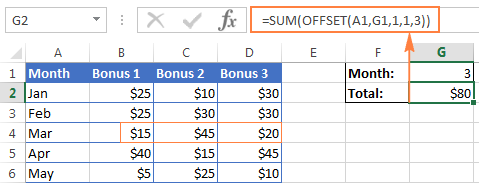
Why practice I use Showtime in Excel?
At present that you know what the OFFSET part does, you may be asking yourself "Why bother using it?" Why not merely write a direct reference similar B4:D4?
The Excel Offset formula is very skilful for:
Creating dynamic ranges: References like B1:C4 are static, meaning they always refer to a given range. But some tasks are easier to perform with dynamic ranges. This is particularly the case when yous work with changing information, e.chiliad. you take a worksheet where a new row or cavalcade is added every calendar week.
Getting the range from the starting jail cell. Sometimes, you may not know the actual address of the range, though you exercise know it starts from a certain cell. In such scenarios, using OFFSET in Excel is the correct way to get.
How to employ OFFSET function in Excel - formula examples
I promise you oasis't get bored with that much of theory. Anyhow, now we are getting to the well-nigh exciting role - practical uses of the OFFSET function.
Excel Showtime and SUM functions
The instance nosotros discussed a moment ago demonstrates the simplest usage of Commencement & SUM. Now, permit'due south look at these functions at some other angle and come across what else they can exercise.
Example ane. A dynamic SUM / OFFSET formula
When working with continuously updated worksheets, you may want to have a SUM formula that automatically picks all newly added rows.
Suppose, you have the source data similar to what yous run into in the screenshot below. Every calendar month a new row is added just above the SUM formula, and naturally, you lot want to take it included in the total. On the whole, in that location are ii choices - either update the range in the SUM formula each fourth dimension manually or have the OFFSET formula exercise this for you.
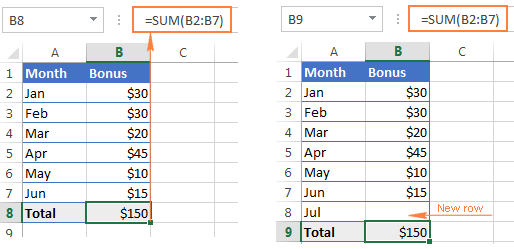
Since the outset cell of the range to sum will be specified directly in the SUM formula, yous only have to decide on the parameters for the Excel Showtime part, which will get that terminal cell of the range:
-
Reference- the cell containing the total, B9 in our example. -
Rows- the prison cell correct above the total, which requires the negative number -one. -
Cols- information technology's 0 considering yous don't want to alter the column.
Then, here goes the SUM / OFFSET formula blueprint:
=SUM(showtime cell:(Start(cell with full, -1,0)
Tweaked for the above example, the formula looks as follows:
=SUM(B2:(Commencement(B9, -1, 0)))
And every bit demonstrated in the beneath screenshot, information technology works flawlessly:
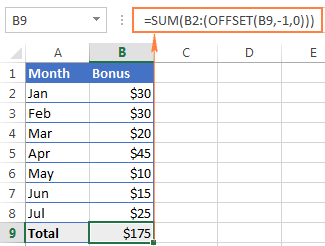
Instance 2. Excel OFFSET formula to sum the last Due north rows
In the higher up example, suppose you want to know the amount of bonuses for the final Due north months rather than grand full. You also desire the formula to automatically include any new rows you add together to the canvass.
For this chore, we are going to utilize Excel OFFSET in combination with the SUM and COUNT / COUNTA functions:
=SUM(Offset(B1,COUNT(B:B)-E1+1,0,E1,1))
or
=SUM(Start(B1,COUNTA(B:B)-E1,0,E1,1))
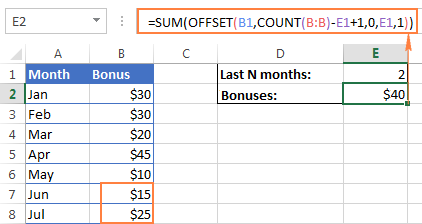
The post-obit details can assistance you understand the formulas meliorate:
-
Reference- the header of the column whose values you want to sum, prison cell B1 in this case. -
Rows- to calculate the number of rows to offset, you use either the COUNT or COUNTA function.COUNT returns the number of cells in cavalcade B that contain numbers, from which you subtract the last N months (the number is cell E1), and add i.
If COUNTA is your function of choice, you lot don't need to add together one, since this function counts all not-empty cells, and a header row with a text value adds an extra cell that our formula needs. Please annotation that this formula will work correctly only on a like table structure - ane header row followed by rows with numbers. For different table layouts, you may demand to make some adjustments in the Starting time/COUNTA formula.
-
Cols- the number of columns to offset is zero (0). -
Tiptop- the number of rows to sum is specified in E1. -
Width- 1 column.
Using OFFSET function with Boilerplate, MAX, MIN
In the same manner as we calculated the bonuses for the last N months, you lot can get an average of the final N days, weeks or years equally well as find their maximum or minimum values. The only difference between the formulas is the get-go function's proper noun:
=Boilerplate(Start(B1,COUNT(B:B)-E1+1,0,E1,1))
=MAX(OFFSET(B1,COUNT(B:B)-E1+1,0,E1,1))
=MIN(Showtime(B1,COUNT(B:B)-E1+1,0,E1,one))
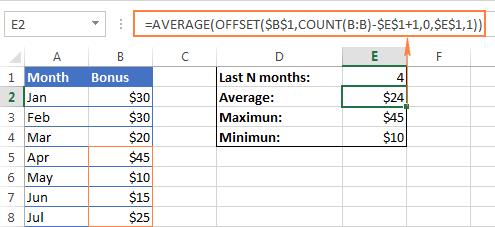
The central benefit of these formulas over the usual AVERAGE(B5:B8) or MAX(B5:B8) is that you won't take to update the formula every time your source table gets updated. No matter how many new rows are added or deleted in your worksheet, the OFFSET formulas will always refer to the specified number of last (lower-near) cells in the cavalcade.
Excel OFFSET formula to create a dynamic range
Used in conjunction with COUNTA, the OFFSET part tin assist yous make a dynamic range that may prove useful in many scenarios, for case to create automatically updatable driblet-down lists.
The OFFSET formula for a dynamic range is every bit follows:
=Starting time(Sheet_Name!$A$one, 0, 0, COUNTA(Sheet_Name!$A:$A), 1)
At the heart of this formula, you use the COUNTA part to go the number of non-blank cells in the target column. That number goes to the pinnacle argument of Start instructing it how many rows to return.
Apart from that, information technology's a regular Starting time formula, where:
- Reference is the starting point from which you base the commencement, for example Sheet1!$A$1.
- Rows and
Colsare both 0 because there are no columns or rows to showtime. - Width is 1 column.
Annotation. If y'all are making a dynamic range in the electric current sheet, there is no need to include the sheet name in the references, Excel volition do information technology for y'all automatically when creating the named range. Otherwise, exist sure to include the sheet's proper name followed past the exclamation indicate similar in this formula example.
One time yous've created a dynamic named range with the to a higher place Offset formula, you can use Data Validation to make a dynamic dropdown list that volition update automatically equally before long as yous add or remove items from the source list.
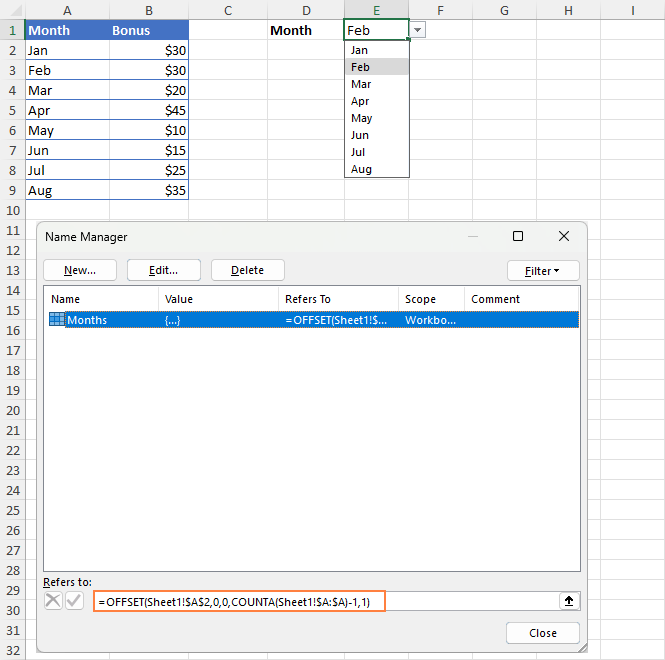
For the detailed step-past-step guidance on creating drop-downwards lists in Excel, please check out the following tutorials:
- Creating drop-downwards lists in Excel - static, dynamic, from another workbook
- Making a dependent drop downward list
Excel Offset & VLOOKUP
As everyone knows, unproblematic vertical and horizontal lookups are performed with the VLOOKUP or HLOOKUP function, respectively. However, these functions have too many limitations and often stumble in more powerful and complex lookup formulas. So, in club to perform more sophisticated lookups in your Excel tables, you lot have to wait for alternatives such as Index, Lucifer and Kickoff.
Example 1. Outset formula for a left Vlookup in Excel
One of the most infamous limitations of the VLOOKUP role is inability to look at its left, meaning that VLOOKUP tin but render a value to the right of the lookup column.
In our sample lookup tabular array, there are two columns - month names (column A) and bonuses (column B). If you want to go a bonus for a sure month, this elementary VLOOKUP formula will work without a hitch:
=VLOOKUP(B1, A5:B11, 2, False)
However, equally soon equally yous swap the columns in the lookup table, this will immediately result in the #N/A error:
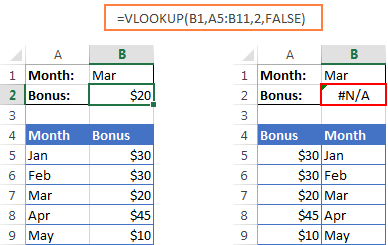
To handle a left-side lookup, yous need a more versatile role that does non really care where the return column resides. One of possible solutions is using a combination of Index and MATCH functions. Some other approach is using Commencement, Lucifer and ROWS:
OFFSET(lookup_table, Lucifer(lookup_value, Get-go(lookup_table, 0, lookup_col_offset, ROWS(lookup_table), 1) ,0) -1, return_col_offset, 1, 1)
Where:
- Lookup_col_offset - is the number of columns to move from the starting point to the lookup column.
- Return_col_offset - is the number of columns to motility from the starting point to the render column.
In our instance, the lookup table is A5:B9 and the lookup value is in cell B1, the lookup column get-go is one (because we are searching for the lookup value in the 2nd cavalcade (B), we demand to move 1 column to the right from the showtime of the table), the render column get-go is 0 considering we are returning values from the first column (A):
=OFFSET(A5:B9, MATCH(B1, First(A5:B9, 0, 1, ROWS(A5:B9), 1) ,0) -i, 0, 1, 1)
I know the formula looks a bit clumsy, but it does work :)
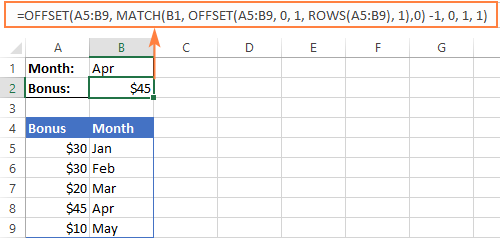
Case 2. How to do an upper lookup in Excel
As is the case with VLOOKUP beingness unable to expect at the left, its horizontal counterpart - HLOOKUP function - cannot expect upwards to return a value.
If y'all need to scan an upper row for matches, the OFFSET Lucifer formula can help again, but this fourth dimension you volition have to heighten it with the COLUMNS function, like this:
Showtime(lookup_table, return_row_offset, Match(lookup_value, OFFSET(lookup_table, lookup_row_offset, 0, i, COLUMNS(lookup_table)), 0) -1, 1, 1)
Where:
- Lookup_row_offset - the number of rows to move from the starting point to the lookup row.
- Return_row_offset - the number of rows to move from the starting signal to the render row.
Assuming that the lookup table is B4:F5 and the lookup value is in cell B1, the formula goes every bit follows:
=OFFSET(B4:F5, 0, MATCH(B1, Commencement(B4:F5, one, 0, ane, COLUMNS(B4:F5)), 0) -one, one, 1)
In our instance, the lookup row beginning is i because our lookup range is 1 row down from the starting point, the return row showtime is 0 considering nosotros are returning matches from the starting time row in the table.

Example 3. 2-style lookup (by column and row values)
Two-way lookup returns a value based on matches in both the rows and columns. And you can use the following double lookup assortment formula to notice a value at the intersection of a certain row and cavalcade:
=Commencement(lookup table, MATCH(row lookup value, Outset(lookup table, 0, 0, ROWS(lookup table), 1), 0) -1, Match(column lookup value, Get-go(lookup table, 0, 0, ane, COLUMNS(lookup table)), 0) -i)
Given that:
- The lookup tabular array is A5:G9
- The value to match on the rows is in B2
- The value to lucifer on the columns is in B1
You get the post-obit two-dimensional lookup formula:
=Beginning(A5:G9, MATCH(B2, OFFSET(A5:G9, 0, 0, ROWS(A5:G9), i), 0)-1, MATCH(B1, OFFSET(A5:G9, 0, 0, 1, COLUMNS(A5:G9)), 0) -1)
It's not the easiest thing to call back, is information technology? In addition, this is an array formula, so don't forget to printing Ctrl + Shift + Enter to enter it correctly.
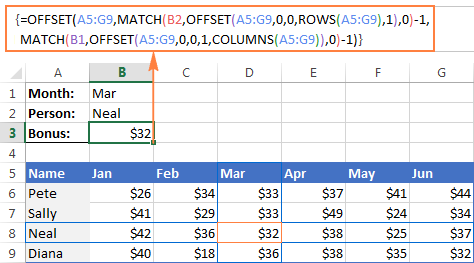
Of course, this lengthy OFFSET formula is non the simply possible way to do a double lookup in Excel. You can get the same result past using the VLOOKUP & Lucifer functions, SUMPRODUCT, or Index & Match. There is fifty-fifty a formula-complimentary manner - to use named ranges and the intersection operator (space). The following tutorial explains all alternative solutions in total detail: How to do 2-way lookup in Excel.
Kickoff role - limitations and alternatives
Hopefully, the formula examples on this page have shed some light on how to utilise OFFSET in Excel. However, to efficiently leverage the part in your ain workbooks, you should not only be knowledgeable of its strengths, but also be wary of its weaknesses.
The well-nigh disquisitional limitations of the Excel OFFSET role are as follows:
- Beginning is a resource-hungry function. Whenever at that place is any change in the source data, your OFFSET formulas are recalculated, keeping Excel decorated for a little longer. This is not an issue for a single formula in a small spreadsheet. But if there are dozens or hundreds of formulas in a workbook, Microsoft Excel may take quite a while to recalculate.
- Excel Showtime formulas are difficult to review. Because references returned past the OFFSET office are dynamic, big formulas (especially with nested OFFSETs) can be quite tricky to debug.
Alternatives to using OFFSET in Excel
Every bit is often the case in Excel, the same result can be achieved in a number of different means. Then, here are three elegant alternatives to Commencement.
- Excel tables
Since Excel 2002, nosotros take a truly wonderful feature - fully-fledged Excel tables, every bit opposed to usual ranges. To make a table from structured data, y'all simply click Insert > Table on the Home tab or press Ctrl + T.
By entering a formula in i cell in an Excel table, you tin create a so-called "calculated column" that automatically copies the formula to all other cells in that column and adjusts the formula for each row in the table.
Moreover, any formula that refers to a table's data automatically adjusts to include any new rows you add to the table or exclude the rows you delete. Technically, such formulas operate on table columns or rows, which are dynamic ranges in nature. Each table in a workbook has a unique name (the default ones are Table1, Table2, etc.) and you are free to rename your table via the Design tab > Properties group > Table Proper name text box.
The following screenshot demonstrates the SUM formula that refers to the Bonus column of Table3. Please pay attention that the formula includes the table's column name rather than a range of cells.
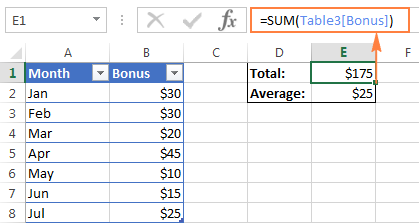
- Excel Index part
Although not exactly in the aforementioned way every bit Kickoff, Excel Index tin too be used to create dynamic range references. Unlike OFFSET, the INDEX function is not volatile, so it won't tedious down your Excel.
- Excel INDIRECT role
Using the INDIRECT office yous can create dynamic range references from many sources such equally cell values, jail cell values and text, named ranges. It can as well dynamically refer to another Excel sheet or workbook. You can detect all these formula examples in our Excel INDIRECT function tutorial.
Do you remember the question asked at the start of this tutorial - What is OFFSET in Excel? I hope now you know the reply : ) If you want some more than hands-on feel, feel free to download our do workbook (please see below) containing all the formulas discussed on this page and contrary engineer them for deeper understanding. Thanks for reading!
Exercise workbook for download
Start formula examples (.xlsx file)
You may also be interested in
Source: https://www.ablebits.com/office-addins-blog/2015/02/11/excel-offset-function/
Posted by: tardywellink.blogspot.com

0 Response to "which function would you use to find the oldest date in a range?"
Post a Comment